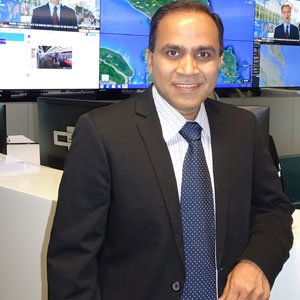THANK YOU FOR SUBSCRIBING

How to Be Creative in Business
Ashok Munirathinam, Senior Director, SAP Cloud Platform, SAP Asia Pacific & Japan


Ashok Munirathinam, Senior Director, SAP Cloud Platform, SAP Asia Pacific & Japan
Although enabled by technology, digital transformation is not about IT. At its core, transformation is about creating improved customer experiences and new business models that deliver impact.
With new ideas, products, and services coming to market at unprecedented rates, transformation is a continuous and iterative process.
This means you must be prepared to disrupt your own business. If you don’t, somebody else will. In recent years we’ve seen many examples of large businesses succumb to new organisations simply able to deliver services in a better way.
Recognising these shifting market dynamics, many businesses are moving focus from product and service innovation to driving outcomes that delight customers. These customers are essentially driving brand direction.
What can your business do to be more customer-focused and creative while keeping operations running? You need to develop an understanding of all business and industry facets – from the way consumers use different touch points through to financial performance – and create an environment where employees can seamlessly communicate and collaborate in response to these.
Technology is a fundamental component in this process, but it’s not the business objective.
A new point of view
The right mix of technologies will help you explore business from new perspectives, reframe existing problems and unlock provocative insights. This is key to meeting the needs and desires of customers and stakeholders.
Design thinking is one of the creative processes made possible by technology. These workshops encourage executives to consider business issues from new angles, with data analysis identifying the most pressing problems to solve and opportunities to capitalise on.
These insights allow executive teams to walk in the shoes of your customers, enabling them to think outside of the corporate bubble, conduct rapid prototyping, test new ideas in market and iterate appropriately. Users are ultimately shaping the final experience.
This is where technology comes in.
For design thinking projects to flourish you need to visualise and interrogate multiple datasets on a single platform. This equips businesses with the detailed and holistic insights they need to make faster and smarter decisions.
With the rise of flexible and agile working practices, communication and collaboration platforms empower employees to work together regardless of location. It ensures everyone can be part of the design thinking process, while providing access to remote and third-party talent that might previously have been inaccessible.
Finally, your business needs to test new products and services in a controlled and risk-free environment, learning how they integrate with existing offerings and gauging customer responses. The right technologies will help refine your offerings long after launch to ensure continuous improvement. Cloud equips your business with the ability to:
• Integrate all types of structured and unstructured data from multiple applications used across the business
• Predict future market demand based on previous learnings and trends demonstrated through the data captured
• Build virtual workforces so people can access data and communicate with peers on projects without having to be physically present
• Conduct pilot launches to gauge initial feedback and make changes where necessary to satisfy customer demand
A design thinking approach including perspectives from many people, rapid iteration and a focus on the human aspect will generate far broader and more innovative ideas than a standard business approach.
Delivering change
Design thinking can be applied across all parts of your business to deliver a better customer experience as demonstrated by these examples from across the region:
Improving internal processes to protect margins – A large retailer in Australia was struggling to manage stock levels and online sales were limited. Rather than simply ordering more products and lowering costs – which would reduce its margins – it used design thinking to identify challenges in its inventory and warehouse management processes. Insights gained from this reframed the challenge and paved the way for a successful outcome.
Delivering superior customer experiences – An Indian car dealership wanted to create a consistent user experience across its various stores – no easy feat considering the diverse population. Armed with multiple insights around its customer base, the company shifted its objective to delivering a consistent emotional experience. From this, several initiatives were identified to enhance the experience based on location. The CEO championed the role of design thinking in this, saying it helped the company think different in a short amount of time.
Improving operational efficiency – Design thinking can also eliminate processes and systems that don’t support business objectives. One of South East Asia’s largest beverage companies wanted to create a system supporting its company vision for 2020 – to drive innovation through growth, diversity, brands, reach and professionalism – the company quizzed employees around the barriers and enablers in a normal working day. Insights helped create a clear roadmap for policies, people, processes and tasks to drive employee engagement.
Unlocking insights and test new ideas – In the wake of profit decline, an electronics provider in Japan was transitioning to a new business model that better supported its strengths. With its new focus, the business needed to equip itself with better understandings of the industries it would now service. Design thinking workshops were used for simulating interactions tailored to trends in each of these sectors, helping generate new ideas to explore and execute.
The creative framework
Creativity is the fuel powering transformation, and while technology will not replace human ingenuity it can help us come up with ideas we might not have considered previously.
Cloud provides the framework to discover these insights, which when considered alongside the other abilities it enables – including deeper analytics, automation, and connectivity – places it at the core of all successful business transformations.












